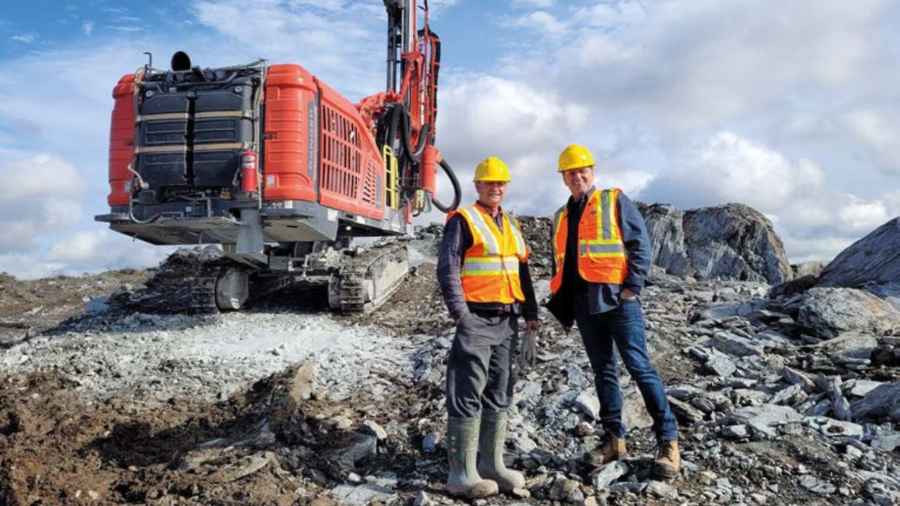The Big Nickel scandal of 1916

In 1854, the land surveyor A.P. Salter noticed the needle on his compass wiggle in strange way, a signal that the bedrock on which he stood contained a huge deposit of nickel (one of the few ferromagnetic minerals that affects the orientation of old-school magnetic compasses). Owing to its remoteness, Salter’s discovery was ignored at the time and soon forgotten. The construction of the Canadian Pacific Railway through the Sudbury basin in the early 1880s brought an influx of newcomers and a transportation link to the region. Among them was a blacksmith named Thomas Flanagan, who in 1883 noticed telltale signs of mineralization (namely, rusty residue associated with oxidization) at a blast site. A staking rush soon followed, as prospectors and early developers laid the foundation for the growth of Ontario’s nickel empire.
More than anyone, the American investor Samuel Ritchie actively promoted Sudbury nickel as the new wonder-metal of modern warfare. But when Ritchie initially created the Canadian Copper Company in 1886, his focus was, as the name of his company suggests, the copper in the Sudbury ore because there was no real market for the much larger supply of nickel. Ritchie also faced the problem of developing a smelting facility that could separate the nickel from the copper and other minerals in the ore.
To overcome these obstacles, Ritchie forged a partnership with Robert M. Thompson, president of the Orford Copper Company of New Jersey, the only firm in North America that had developed a large-scale process for smelting nickel ore. Orford helped to design a facility to produce nickel matte in Copper Cliff (now part of Sudbury), but the final smelting would take place at Orford’s New Jersey plant. To develop a market for nickel, Ritchie lobbied General Benjamin Tracy, Secretary of the U.S. Navy, to conduct experiments on the development of a nickel-steel alloy that was strong and durable enough for military purposes.
The new nickel-steel armour plating was so effective, the U.S. Navy pursued a massive ship-building program in the 1890s to modernize their fleet. In 1902, the all-important nickel supply chain connecting Sudbury to New Jersey was further reinforced when J. Pierpont Morgan bought Orford and the Canadian Copper Company and merged them to create the International Nickel Company (shortened to Inco in 1919). Some Canadian politicians grumbled about the fact that Inco was exporting a partially refined product that could be smelted in Canada. Ironically, Samuel Ritchie, bitter because he had been ousted from the board of the Canadian Copper Company in 1891, worked with sympathetic businessmen to lobby for an export tax on nickel matte to support the development of a nickel smelter in Canada. Most in the mining industry opposed the idea. The Canadian Mining Review urged the government to “let the mining industry have a free chance to develop and strengthen itself; to gather a population of consumers around it; to give natural birth to associated industries.” The government mostly acceded to this sentiment, at least until World War One brought the debate over nickel processing to a fever pitch.
On July 9, 1916, the German cargo submarine, the Deutschland, arrived in the port of Baltimore, one of two commercial cargo submarines built to avoid the British naval blockade of the Atlantic shipping lanes. With the U.S. not yet fighting in the war, the submarine crew members were feted as celebrities, as their curious vessel and daring journey across the Atlantic seemed to capture the public imagination. The spectacle of the American media celebrating a German submarine likely rankled Canadians, but when The Providence Journal reported that the return cargo would include 341 tonnes of nickel that was likely mined in Sudbury, the reaction was fast and furious. On July 12, the editors of The Globe captured the public mood when they opined, “not a pound of metal, whether wholly or partially refined, should be permitted to reach Germany from Canada.” They went on to argue that “nothing short of the government control of the refining of nickel in Canada, probably including government ownership of the refining plants, will now satisfy the people of Canada.”
At first, the government and industry denied the story. G. Howard Ferguson, Ontario’s minister of lands, forests, and mines, told The Globe that if the Deutschland were to reach the open Atlantic safely, “it will not contain one ounce of Canadian nickel.” In a shot aimed at his interviewers, Ferguson argued that “the newspaper editor who sits in his office and tells the public that Canadian nickel is in danger of reaching enemy shores is not only falsifying conditions, but seriously injuring recruiting.” Ferguson claimed that the British government tracked every ounce of nickel that left Canada, and it was “absurd” to claim that the government would allow it to fall into the hands of the enemy. James T. Ashley, treasurer of Inco, also denied the story, claiming that all nickel sales remained under the control and supervision of the Canadian government.
But the story did not end there, mostly because nobody could provide convincing evidence that the nickel aboard the Deutschland was not from Sudbury. On the contrary, The Globe reported that George P. Graham, a member of parliament with the opposition Liberals, had traveled to New York on July 18 and interviewed businessmen familiar with nickel markets. One of Graham’s contacts suggested he had bought tens of thousands of dollars of nickel from Sudbury, with no restriction on where he could sell it internationally. As late as November 1916, The Globe castigated Arthur Meighan, the federal solicitor general, for arguing, without proof, that the nickel on the Deutschland must have come from mines in the U.S.
Despite the public arguments, the damage was done. The government and industry had little choice but to mollify the public outrage. Inco created a Canadian subsidiary on July 25, 1916, which helped to pacify Canadian economic nationalists. More importantly, in early August, the company committed to build a nickel smelter in Port Colborne, Ont. (Sudbury lacked the requisite power supply), which created an all-Canadian nickel production process once the plant was completed in 1918. While the industry had favoured continental integration, nickel’s status as a strategic wartime metal forced the consolidation of operations within Canada. From Inco’s point of view, it was fate preferable to the public demands for a government takeover, one that allowed Inco to maintain its virtual lock on continental nickel supplies and feed the ongoing demand for nickel, especially in the U.S., as major military conflicts continued to erupt throughout the 20th century.
John Sandlos is a professor in the History Department at Memorial University of Newfoundland and the co-author (with Arn Keeling) of “Mining Country: A History of Canada’s Mines and Miners,” published by James Lorimer and Co. in 2021.





Comments